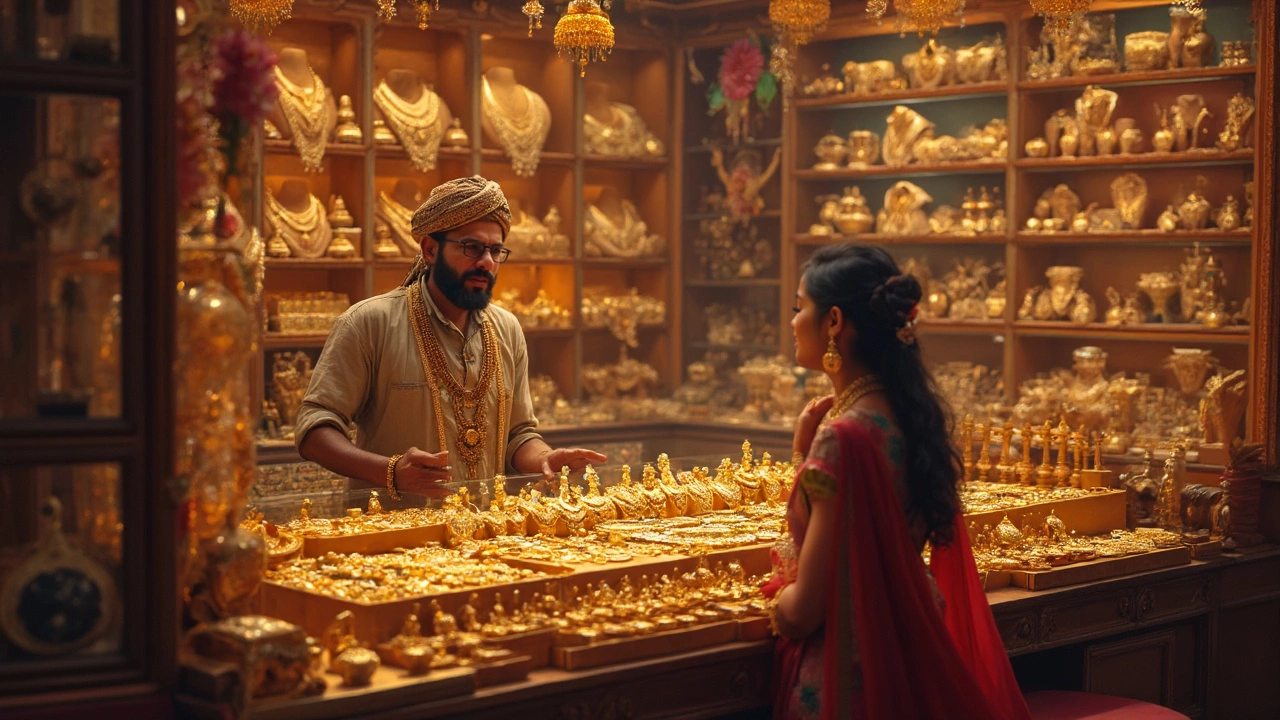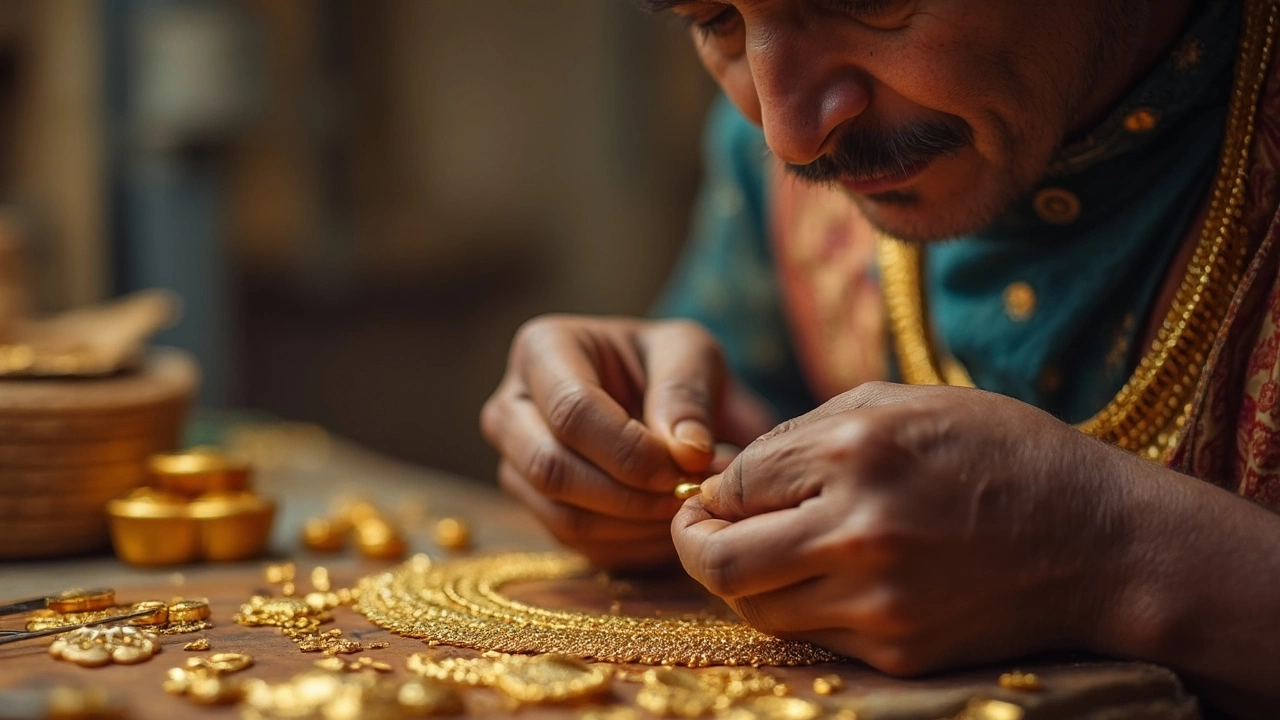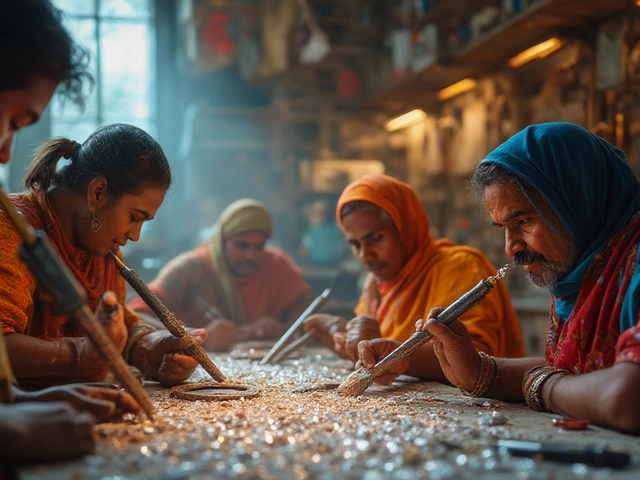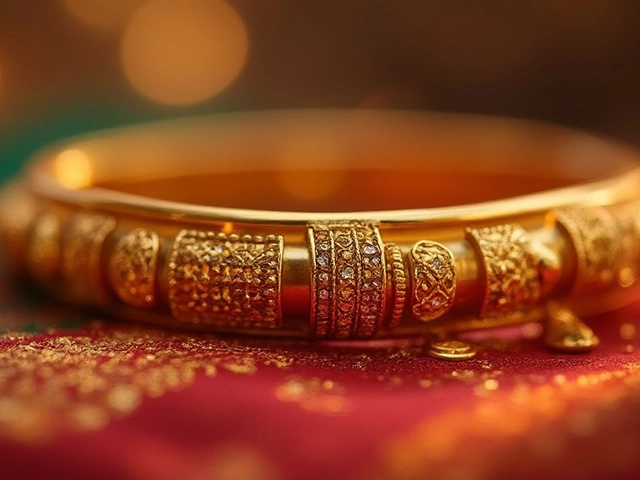
When we talk about gold jewellery, it’s not just about the glam factor. Some gold pieces are worth more than others, but why is that? It all boils down to purity and craftsmanship. Generally, gold purity is measured in karats (or carats, depending on where you are), and the higher the karat, the purer the gold. For example, 24-karat gold is as pure as it gets, with no other metals mixed in. But hold on, because there’s more to it than just the numbers.
Here's something many people don't know: the higher the gold purity, the softer and more malleable the material. That’s why 24-karat gold jewelry, while valuable, might not be as durable as 18-karat or 14-karat pieces. If you’re someone who likes to show off your treasure trove daily, thinking about durability might be a good idea.
But purity isn’t the only thing impacting value. The design also plays a massive role. Some handcrafted pieces with intricate designs reflect a higher value due to the artistry and time involved. Plus, designs tracking current fashion trends can fetch higher prices simply because they’re in demand.
- Understanding Gold Purity and Karats
- Historical and Cultural Gold Values
- Designs That Impact Gold Value
- Market Trends in Gold Jewellery
- Investing Wisely in Gold
- Caring for High-Value Gold Pieces
Understanding Gold Purity and Karats
Alright, let’s dig into the nitty-gritty of gold value. When it comes to measuring gold purity, the term karat is king. But what does that even mean? In simple terms, a karat is a unit that measures the purity of gold, with 24 being the purest form - you know, the real deal.
So, what exactly is 24-karat gold? It's pure gold, consisting of 100% gold without any other metals. However, pure gold is super soft, which makes it a bit impractical for making everyday jewellery, which is why it’s rare unless you're holding onto it as an investment or a collectible.
Gold Karat Breakdown
Let’s break it down further:
- 24K (Pure Gold): 99.9% gold. Highly valued for its purity but is soft and often not used for intricate designs.
- 22K Gold: About 91.6% pure gold mixed with other metals like copper or silver. It’s popular for making substantial jewellery, especially in places like India.
- 18K Gold: This is 75% gold and 25% other metals. It strikes a nice balance between durability and a high gold content, making it popular for quality jewellery.
- 14K Gold: Contains 58.3% gold. It’s a bit more durable and is prevalent in the U.S. market for a good mix of durability and affordability.
- 10K Gold: Just 41.7% gold. It’s the most durable because of the higher percentage of other metals—it won't break the bank, but don’t expect much resale value.
Why Understanding Karats Matter
Knowing a piece’s karat helps assess its market value but also influences other factors like color and suitability for daily wear. Gold purity affects the hue, with purer gold appearing more vibrant and rich. Also, higher karat pieces are softer, which means they can scratch or bend more easily.
Here’s a quick stat: According to the World Gold Council, about 78% of the annual gold supply is used in jewellery. That’s a truckload of gold jewellery swirling around! Understanding karats is key not just for your next purchase but also if you’re considering gold as an investment.
By getting familiar with what you're buying, you make sure you're getting good value and not just a pretty, shiny object. Whether you’re in it for the looks, the value, or the investment potential, a grasp of gold purity and karats ensures you’re informed and ready for your next golden opportunity.
Historical and Cultural Gold Values
Gold has been a symbol of wealth and power across different cultures and historical periods. From ancient Egyptian pharaohs to modern-day investors, the allure of gold value has always been a constant. The Egyptians were among the first to mine and use gold, seeing it as the embodiment of the sun god Ra.
In the Roman era, gold was used to mint coins, influencing the entire economy and trade systems of the times. The Romans perfected mining techniques, allowing them to generate substantial wealth, leading to opulent jewelry designs that are still admired today.
"The chief contributions of gold to human affairs have come in its economic roles as money and as a source of savings." — Peter Bernstein, author of 'The Power of Gold'
Jumping to Asia, the cultural significance of gold in India stands out remarkably. India has long valued gold not just for its worth but for its religious and social significance. Gold jewellery holds a special place in wedding ceremonies, believed to bring fortune and prosperity.
The West's Golden Era
During the California Gold Rush of 1849, the United States saw a meteoric rise in gold mining and economic growth. This era sparked a global interest, setting gold jewellery as an invaluable asset. The rush for gold not only affected economies but also led to the transformation of towns and cities, leading to technological advancements in mining techniques.
Even today, cultural events like Chinese New Year showcase gold's importance across societies. Whether it’s in the form of intricate gold designs or bars, gold gifts symbolize prosperity and wealth.
Over the decades, gold has repeatedly proven its stability during times of economic uncertainty, making it a go-to investment during financial downturns.
| Period | Cultural Significance |
|---|---|
| Ancient Egypt | Symbol of divine power |
| Roman Empire | Foundation of currency |
| India | Religious and social importance |
| California Gold Rush | Economic driver |
Designs That Impact Gold Value
When it comes to gold jewellery, the design isn't just about looking pretty; it's a big player in determining the piece's worth. Believe it or not, the intricacy and uniqueness of a design can sometimes make a piece of lower karat gold more valuable than one with higher purity. Now, let's see how that works.
Handcrafted vs. Machine Made
Handcrafted pieces often carry a higher value because of the craftsmanship involved. Imagine a goldsmith spending hours or even days on a single piece – every detail is the result of skilled hands. It's like owning a tiny piece of art. In contrast, machine-made designs, while precise, lack that personal touch. Sure, they can be stunning, but they're often mass-produced, which can diminish the value.
Design Complexity
Complex designs usually bump up the worth of jewellery. Why? More detailed work requires more time and effort, and sometimes, even specific expertise that not every jeweler has. A piece with filigree patterns, for example, showcases a technique where delicate threads of gold are twisted and soldered. It's labor-intensive and, thus, more valuable.
Trends in Gold Jewellery
Interestingly, trendy designs can also affect the value. A design that's in vogue can fetch a higher price because it's in demand. Think of popular pieces like minimalist bars or geometric patterns recently seen on runways – their desirability can spike their worth significantly.
Here's a tip: When choosing trendy designs, consider whether you'll love it long after the trend fades. If personal taste aligns with market trends, you’ve hit the jackpot!
Collaboration Pieces
Pieces made in collaboration with renowned designers or celebrities often get an instant value boost. These pieces can be rare, making them highly sought after and, consequently, more expensive. Think of it as the difference between a limited edition sneaker and a standard one.
Historical Designs
Lastly, some designs carry historical significance, further elevating their value. Vintage or antique styles, especially those that reflect specific eras, not only hold monetary worth but are also rich in stories. Owning a piece that feels like it has a past can be alluring and bring a sense of nostalgia.
In conclusion, when considering gold jewellery, it's smart to look beyond the gold’s karats. Factor in design, artistry, and trends to truly understand what makes some pieces more valuable than others. After all, the design speaks volumes about both the piece and the wearer.

Market Trends in Gold Jewellery
Gold jewellery is one of those timeless items that’s always in style, but how it's styled can shift faster than you'd think. Right now, there’s a strong trend towards bold, statement pieces that are impossible to miss. Think chunky necklaces and oversized rings. These types of designs are grabbing attention and sending value skyward.
According to a recent report by the World Gold Council, gold demand for jewellery saw a rebound in 2024, particularly in emerging markets like India and China. An interesting tidbit from their report states,
"The increasing urban population with rising disposable incomes has driven a renewed interest in high-end gold jewellery."That means there’s a lot of room for investment and growth in these areas.
Vintage and Sustainable Styles
Another cool trend is the rise of vintage-inspired and sustainable designs. People love a good nostalgia trip mixed with environmental responsibility these days. Recycled gold jewellery is becoming especially popular among eco-conscious consumers willing to pay a premium for ethically sourced items.
Technology Meets Tradition
Tech is shaking up how we think about jewellery too. New methods like three-dimensional printing allow for highly customized designs. Imagine having a one-of-a-kind piece that suits your style perfectly! How neat is that?
Keeping an Eye on Market Prices
Given these dynamic trends, staying updated on market prices can give you an edge. Watching indices and evaluating when gold hits seasonal highs or lows might help in getting good deals or maximizing investments.
| Year | Gold Price (USD) |
|---|---|
| 2023 | 1,800 |
| 2024 | 2,000 |
In conclusion, whether you're a buyer or an investor, keeping tabs on these market trends can make a big difference. With bold designs, attention to sustainability, and a sprinkle of tech, the world of gold jewellery is as exciting as ever. Investing wisely and staying stylish can definitely go hand in hand.
Investing Wisely in Gold
Investing in gold jewellery can be a savvy way to combine wealth preservation with a love for bling. But how do you make sure you’re making a smart investment? Here are some tips to consider when diving into the gold market.
Understanding Market Trends
Keep a close eye on market trends. The price of gold can fluctuate due to inflation rates, currency value changes, and geopolitical tensions. By understanding these trends, you can decide the best time to buy or sell your gold.
Diversify Your Gold Portfolio
Just like any other investment, diversity is key. Don’t put all your money into one type of gold jewellery. Mix it up with varying karat values or even different gold items like coins or bars. This can hedge against market downtrends.
Authentication and Certification
Always ensure your gold is authenticated. Look for certifications from trusted authorities that guarantee the gold's purity. This is crucial if you decide to sell it later on, as certified pieces are easier to market and command higher prices.
Consider Cost versus Value
While you might be tempted by heavily embellished pieces, keep an eye on the price-to-value ratio. Intricate designs can boost aesthetic appeal but might not always result in higher resale value. Simpler, purer pieces tend to hold value better had the additional gold remains easily recognizable and tradable.
Long-Term Versus Short-Term Goals
Define your investment goals upfront. Are you looking for quick profits or a long-term value increase? Gold tends to perform well as a long-term asset, slowly appreciating in value over time. Short-term gains can occur but require a higher risk tolerance and market knowledge.
| Type of Gold | Average Annual Return (10 Years) |
|---|---|
| Gold Bars/Coins | 5% |
| Gold Jewellery | 3.5% |
By following these tips, you can make informed decisions and invest wisely in gold. Remember, like any investment, it's a journey that involves both risk and opportunity.
Caring for High-Value Gold Pieces
Your gold jewellery, especially the high-value pieces, deserve some tender love and care. It’s not just about keeping them shiny but also ensuring they last a lifetime. One of the simplest yet most effective things you can do is to clean your gold jewellery regularly. This helps to remove any dirt or oils that may accumulate over time.
Regular Cleaning Routine
It's a good idea to have a straightforward cleaning routine. Use warm water and a bit of mild dish soap. Let the jewellery soak for about 10-15 minutes and then gently scrub with a soft toothbrush. Rinse and pat dry with a soft cloth. Trust me, this makes a world of difference.
Storage Tips
When you're not wearing your jewellery, proper storage is key. Keep your valuable pieces in a soft-lined box or in separate compartments to prevent scratches. Consider wrapping each piece in a cloth or using small jewellery pouches.
Avoid Chemicals
Chemicals like chlorine and bleach can damage gold. So, take your gold pieces off before jumping into a pool or getting into any cleaning activities. Also, try putting on your jewellery after applying lotions and perfumes to minimize contact with chemicals.
Professional Check-Up
If you want to ensure your most valuable gold pieces stay in top condition, a professional jeweller’s check-up once a year won’t hurt. They can spot issues you might miss, like loose settings or weak clasps, saving you from losing a piece in the future.
Remember, caring for your gold jewellery doesn't have to be a chore. With a few proactive steps and regular maintenance, your jewelry will maintain its brilliance and, most importantly, its gold value.


